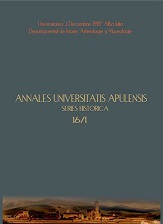Descoperiri monetare în zona cetăţii dacice de la Cugir
Money discoveries in the Dacian fortress area of Cugir
Author(s): Cristian I. PopaSubject(s): Archaeology
Published by: Editura Mega Print SRL
Keywords: coin hoards; Dacian coins; coin imitations; Macedonia Prima tetradrachms; Aiud-Cugir; Răduleşti-Hunedoara; Toc-Chereluş; Philip II; Cugir
Summary/Abstract: This study aims at presenting the history of the Dacian fortress of Cugir based on the monetary findings, found within the citadel itself or nearby. The first coin hoard (Cugir I) is known since 1868 and contains around 200 silver coins. Most of them were scattered away, some entering various collections, only a few pieces ending up with the specialists. The hoard, hidden in a vessel, contained an unspecified number of Thasos tetradrachms, eight issued in Macedonia Prima, Dacian tetradrachms of Aiud-Cugir and Răduleşti-Hunedoara types, a drachma imitating an issue from Alexander the Great - Philip the IIIrd’ Arrhidaeus and a unique drachma. In the same period was recorded the discovery of another important hoard, containing several items (bracelets, rings and pieces of harness) as well as pre-Roman gold coins. The hoard, according to Josef Lewitzky, the one that published the information in 1901, was found by accident when quarrying the hill west of Cetate for construction materials. The most important part of the hoard ended up in Budapest and the rest was melted in Alba Iulia. We do not know if this hoard is different from the one mentioned in 1868 (Cugir I). The second coin hoard (Cugir II) was discovered in 1955, at the base of the western part of Dealul Cetăţii (the Citadel’s Hill), in a place called Valea Viilor. Hidden in a ceramic vessel, the hoard contained an approximate number of 2000 silver coins. The items recovered right after the discovery contained eight Macedonia Prima tetradrachms and an imitation of Philip II (kept in the collections of the Dacian and Roman Civilizations Museum at Deva), were published by Octavian Floca. Later, other pieces were recovered from the locals by Ion H. Crişan: a Dacian coin of Răduleşti-Hunedoara type and four Macedonia Prima tetradrachms, these last ones remaining unpublished until now and kept within the collections of the Union’s Museum in Alba Iulia. In total, from this hoard, we have 14 coins (12 Macedonia Prima tetradrachms, one coin from Philip II, a Dacian coin of Răduleşti-Hunedoara type). The remaining quantity was melted into silver ingots by the locals. If completely recovered this would have been one of the largest hoards in pre-Roman Dacia. In 1937 on Dealul Cetăţii from Cugir the priest Oancea of Cioara recovered two imperial coins from Domitianus. Several other coins were found isolated around the Cugir citadel. Some of these are described since 100 years ago, without any depiction of items. One Dacian coin comes from a systematically researched house. Other coins come from the same excavations and can be dated at the end of the 2nd Century BC and were issued by the Greek city of Odessos. Also from Cugir we have the coin kept in the collection of the Coin Cabinet of the Romanian Science Academy in Bucharest, a Dacian issue of Toc-Chereluş type.
Journal: Annales Universitatis Apulensis Series Historica
- Issue Year: 16/2012
- Issue No: 1
- Page Range: 7-36
- Page Count: 30
- Language: Romanian
- Content File-PDF

